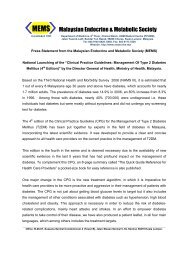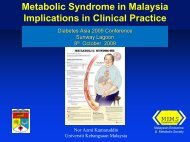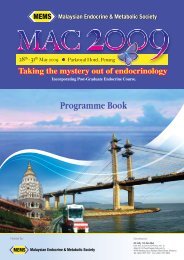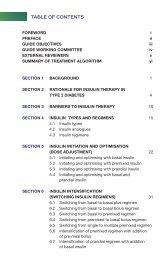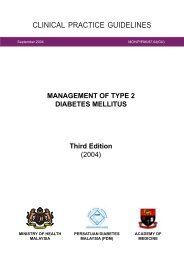JAFES-Booklet (English - pdf - 1103 Kb) - MEMS
JAFES-Booklet (English - pdf - 1103 Kb) - MEMS
JAFES-Booklet (English - pdf - 1103 Kb) - MEMS
Create successful ePaper yourself
Turn your PDF publications into a flip-book with our unique Google optimized e-Paper software.
TSH- Secreting Pituitary Macroadenoma:<br />
A Rare Cause Of Thyrotoxicosis<br />
Norhaliza MA, Zanariah H, Nurain MN<br />
Endocrinology Unit, Department of Medicine, Hospital Putrajaya<br />
TSH-secreting pituitary adenoma (TSH-oma) is a rare cause of thyrotoxicosis and accounts for<br />
only 1-2% of all pituitary adenomas. The diagnosis is usually made much later in a patient who<br />
has been diagnosed earlier with thyrotoxicosis. We report a case of a patient who was diagnosed<br />
to have thyrotoxicosis during follow up of her pituitary adenoma, which was initially thought to be<br />
a non-functioning pituitary adenoma.<br />
A 25-year-old lady was diagnosed to have pituitary apoplexy when she presented with acute left<br />
eye blindness and headache. MRI of the pituitary revealed the presence of a large pituitary mass<br />
measuring 3.5 x 3.0 x 2.8 cm with suprasellar extension, compression of the optic chiasm, left<br />
cavernous sinus and intracavernous portion of the left internal carotid artery (ICA). She underwent<br />
transsphenoidal surgery and histological examination showed presence of infarcted<br />
pituitary adenoma. The pituitary tissue was stained positive for prolactin and growth hormone,<br />
while staining for ACTH, FSH, LH and TSH were negative. Serum FT4 was 13.2 pmol/l (9-19<br />
pmol/l) and TSH was 0.38 mU/L (0.35-4.94 mU/L), while other anterior pituitary hormones were not<br />
available.<br />
Her vision improved post-operatively and a MRI performed three months later showed evidence<br />
of a residual pituitary tumor measuring 2.0 x 1.8 x 1.8 cm with encasement of the cavernous<br />
portion of the left ICA. Her thyroid function was normal; serum FT4 level was 18.1 pmol/l (9-19<br />
pmol/l) and TSH level was 1.94 mU/L (0.35-4.94 mU/L). Other anterior pituitary hormones were<br />
also within normal limits. However six months later, thyroid function tests noted elevated serum<br />
FT3 and FT4 levels with non-suppressed TSH.<br />
In view of the underlying pituitary adenoma, diagnosis of thyrotoxicosis secondary to TSH-oma<br />
was made. This was supported by an elevated _-subunit of 3.09 IU/L (0.05-0.4 IU/L). However<br />
TRH- stimulation test was positive, which is not classical of TSH-oma. She was planned for a trial<br />
of medical therapy with a somatostatin analogue.<br />
34



